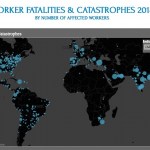Today, the Centers for Disease Control and Prevention released new data on heat deaths among U.S. workers, underscoring the often-tragic consequences that result when employers fail to take relatively simple and low-cost preventive actions.
Published in today’s issue of CDC’s Morbidity and Mortality Weekly Report (MMWR), researchers reviewed two years worth of OSHA enforcement cases that were investigated under its general charge to uphold safe and healthy workplaces. (OSHA investigates workplace heat illness and death via the “general duty clause” of the Occupational Safety and Health Act of…
Occupational health
For 17 years, Salvadora Roman deboned chickens on the processing line at Wayne Farms in Decatur, Alabama. In particular, she deboned the left side of the chicken — a task she was expected to perform on three chickens each minute during her eight-hour shift. Because of the repetitive movement and speed of the processing line, Roman developed a chronic and painful hand injury that affects her ability to do even the most basic household chores. About three years ago, she was fired from the plant for taking time off work to visit a doctor for the injury she sustained on the line.
“My hand started…
Fast food workers may have just received a huge boost, thanks to a ruling from the National Labor Relations Board.
Steven Greenhouse reports in The New York Times that the board’s general counsel has ruled that McDonald’s is jointly responsible for labor violations at its franchises — “a decision that if upheld would disrupt longtime practices in the fast-food industry and ease the way for unionizing nationwide,” Greenhouse writes. The article reports that of the 181 unfair labor practice complaints filed against McDonald’s and its franchises in the last 20 months, the board’s counsel decided…
When Bethany Boggess first debuted her online mapping project, she didn’t expect it to attract so much attention. But within just six months of its launch, people from all over the world are sending in reports and helping her build a dynamic picture of the lives and deaths of workers.
The project is called the Global Worker Watch and it’s quite literally a living map of worker fatalities and catastrophes from around the globe. When you go to the site, you’ll see a world map speckled with blue dots, each representing a reported occupational death, illness or disaster. Here are just a few I…
Serious health problems are driving workers at a car part manufacturer in Alabama to call for a union. In an in-depth article for NBC News, reporter Seth Freed Wessler investigated occupational exposures at the Selma-based Renosol Seating plant, where workers make foam cushions for Hyundai car seats and headrests. According to the story, at least a dozen current and former employees report sinus infections, chronic coughs, bronchitis, shortness of breath and asthma since working at the factory. The story begins with worker Denise Barnett:
Denise Barnett was thankful seven years ago when she…
What do these places have in common: Camp Lejeune in North Carolina; Mountain View, California, where Google headquarters are located; Endicott, NY – the birthplace of IBM; and 389 Superfund sites in at least 48 states plus Puerto Rico and the Virgin Islands? All are contaminated by trichloroethylene (TCE), a volatile organic compound classified as a carcinogen that’s been widely used as a solvent and degreaser in large-scale industrial processes, small commercial shops and in some products used by individual consumers. On June 25th, the Environmental Protection Agency (EPA) released its…
Crystalline silica, hydrofluoric acid and formaldehyde. Those are just three of the dozens of air toxic chemicals that oil companies have used thousands of times in southern California in just the past year.
The data has come to light thanks to new reporting rules adopted in 2013 by the South Coast Air Quality Management District, which now requires oil and gas well operators to disclose the chemicals they use in oil and gas operations. According to a recently released analysis of the first year’s worth of reported data, oil companies used 44 different air toxic chemicals more than 5,000…
The U.S. Supreme Court released two big decisions yesterday. The first, which you’ve probably heard about, ruled that for-profit companies can deny female employees insurance coverage for birth control if it conflicts with their religious beliefs. (For more on the potential consequences of this outrageous and offensive decision, read this great piece in Slate. Also, since this is the Occupational Health News Roundup, it bears mentioning that in her dissent, Justice Ginsburg noted that the cost of an IUD is about a month’s full-time pay for a worker earning minimum wage.) But in addition to…
When a widely used chemical is identified as an environmental health hazard and targeted for phase-out and elimination, among the most challenging questions for those involved with using and making such a chemical are: What to use instead? and Will the replacement be safe? The US Environmental Protection Agency’s (EPA) report identifying alternatives to the flame retardant hexabromocyclododecane (HBCD) illustrates how difficult those questions can be to answer. It also highlights how important it is to consider the entire life-cycle of finished products when looking for hazardous chemical…
Just yesterday, the Obama administration announced it would take executive action to protect certain workers against discrimination based on sexual orientation. The Associated Press reports that the president plans to sign an executive order prohibiting federal contractors from discriminating against workers based on sexual orientation and gender identity. The order is estimated to protect about 14 million workers who are not currently protected against such discrimination. The administration did not say exactly when the president would sign the executive order.
The Associated Press article…
Following the deadly April 17, 2013 explosion at the West, Texas West Fertilizer Company plant that killed fifteen people and injured hundreds – and a series of other catastrophic incidents involving hazardous materials – President Obama issued Executive Order 13650. It directed federal agencies to improve the safety and security of chemical facilities to reduce risks to workers, communities and first responders. To do so it established a working group, led by the Department of Labor, Environmental Protection Agency (EPA) and Department of Homeland Security, that would report back to the…
Where you live may be hazardous to your health. This is the conclusion of several recent reports and studies, among them a supplement to the most recent examination of health disparities by the US Centers for Disease Control and Prevention (CDC) and an analysis by the Environmental Justice and Health Alliance for Chemical Reform of those who live in communities most vulnerable to hazardous chemical exposures. Together the two paint a disturbing picture of how the neighborhoods in which Americans live and work play a significant role in determining their residents' health. There should be no…
Coal miner turned whistleblower Justin Greenwell is at the center of a Huffington Post article investigating how the mining industry cheats the worker safety system. Greenwell, who’s now in a legal battle to get back his mining job with Armstrong Coal, a subsidiary of St. Louis-based Armstrong Energy, tipped off federal mine inspectors that the company was submitting misleading coal dust samples to regulators. The samples are used to determine whether a mine is in compliance with safety and health standards designed to protect miners from black lung disease. According to a 2008 posting from…
The heath effects of occupational solvent exposure don’t always fade with time. A new study has found that years — sometimes even decades — down the road from their last workplace exposure, some workers are still experiencing very real cognitive impairments.
“Cognitive problems are pretty common at older ages and even though they are really common, we don’t know much about what causes them or how to prevent them,” said study co-author Erika Sabbath, a research fellow at Harvard School of Public Health. “There’s a large body of evidence that solvents are this group of occupational chemicals…
The Pump Handle’s own Celeste Monforton was quoted in an investigative piece on the tank cleaning industry and the dangerously toxic environments that its workers face. In an investigative article in the Houston Chronicle, reporter Ingrid Lobet found that even though industry workers are coming into contact with extremely toxic and often combustible chemicals, the methods that the Occupational Safety and Health Administration uses to track tank and barge cleaning operations is woefully deficient.
Lobet begins her story with the life and death of David Godines, a Houston tank cleaner found…
Two years ago, domestic workers in Houston, Texas, took part in the first national survey documenting the conditions they face on the job. The experience — a process of shedding light on the often isolating and invisible world of domestic work — was so moving that Houston workers decided they didn’t want to stop there. Instead, they decided it was time to put their personal stories to paper.
The result is “We Women, One Woman!: A view of the lived experience of domestic workers,” which was officially released last month. The anthology features the stories of 15 nannies, house cleaners and…
In 2012, the most recent year for which US Bureau of Labor Statistics (BLS) figures are available, 375 people died on the job in California – an average occupational fatality rate of more than one person every day. At the same time, research by Worksafe and other California labor advocates shows that while California’s workforce has grown by about 22 percent in the last 20 years, the number of safety inspectors for the 17 million people employed in the state’s 1.34 million workplaces has decreased by about 11 percent. This leaves California – which has the largest workforce of any US…
In New York, construction is the deadliest industry, with immigrant workers experiencing half of all occupational-related fatalities. Across the country in California in 2012, transportation incidents took the unenviable top spot as the leading cause of workplace fatalities. In Massachusetts in 2013, it’s estimated that upward of 500 workers died from occupational disease, at least 1,800 were diagnosed with cancers associated with workplace exposures and 50,000 workers experienced serious injury. In Wyoming, workplace deaths climbed to a five-year high in 2012, from 29 in 2011 to 35 in 2012.…
The Coalition of Immokalee Workers’ Fair Food Program has garnered praise from the White House to the United Nations for its innovative strategies to improve working conditions among farmworkers in Florida. The program, which began in 2010, works by getting big buyers to agree to only purchase tomatoes from farms that adhere to worker protection rules and ensure that workers are educated on their rights and responsibilities. Businesses that have signed on include Taco Bell, Chipotle and, recently, Wal-Mart, which according to a New York Times article chronicling progress on Florida farms,…
Climbing the corporate ladder is usually associated with promotions, salary raises and executive offices. But for many workers, the common metaphor is part of a real-life job description with real-life risks.
Last week, the Centers for Disease Control and Prevention released new data on occupational ladder falls, finding that a fifth — or 20 percent — of all fall injuries among workers involve a ladder. Among construction workers, 81 percent of all fall injuries treated in an emergency department involved a ladder (overall, falls are a leading cause of death in construction). In 2011, CDC…

